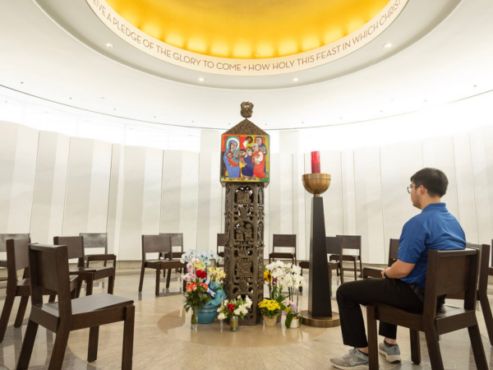AS FAR BACK AS Moses in the Old Testament, the tabernacle has been a place for people to encounter God’s presence. When the Hebrew tribes wandered through the desert before reaching the Promised Land, they used a tent or small sanctuary to house the Holy of Holies.
Now, in designs that are as varied as the Catholic churches that house them, tabernacles are where the consecrated Body of Christ is reserved and worshiped.
Located in Blessed Sacrament chapels or in alcoves off to the side of altars, tabernacles can be considered the heart of the worship space.
“The tabernacle is where you find the enduring presence of Christ,” said Fr. Al Baca, Episcopal Vicar for Ecumenism and Inter-religion for the Diocese of Orange. “The tabernacle is the silent presence of Christ among us. It is a powerful invitation to believers to approach God in moments of peace and of pain. We meet Christ most perfectly in the celebration of the Holy Eucharist, the Mass. The reserved Eucharist in the tabernacle affords us the opportunity to engage Christ in the quiet, in reflection.
The Garden Grove campus of Christ Cathedral is home to three tabernacles. One recently was installed, and the newest one will be blessed in October. Taking a look at tabernacles is fitting as the three-year National Eucharistic Revival, which launched on the feast of Corpus Christi in 2022, continues. That undertaking of U.S. Catholic bishops aims to “renew the Church by enkindling a living relationship with the Lord Jesus Christ in the holy Eucharist.”
HISTORY AND SOME FACTS
The word “tabernacle” derives from the Latin tabernāculum (“tent” or “hut”).
As Fr. Baca noted, tabernacles have developed differently through the centuries. During the Middle Ages, in some parts of Europe, the tabernacles could be seen suspended from cathedral ceilings above the altar. Some were designed to look like a dove, the image of the Holy Spirit.
In the early centuries of the Christian era, the Blessed Sacrament was not reserved in a tabernacle.
That custom began by the fourth century, when the Eucharist was reserved for those who were ill or near death. Over the ensuing centuries, tabernacle vessels developed as well as devotion to the reserved Blessed Sacrament.
According to Canon Law, tabernacles should be immobile, made of solid material and remain locked.
After the Diocese of Orange was formed in 1976, Bishop William Johnson required that all tabernacles be alarmed on account of a series of thefts where tabernacles were damaged, ciboria stolen and the Blessed Eucharist sacrileged.
In addition to the Christ Cathedral tabernacle and the one at the soon-to-open St. Callistus Chapel and Crypts of Christ Cathedral, particularly beautiful tabernacles include those at St. Anne’s in Seal Beach, St. Anne’s in Santa Ana, St. Elizabeth Ann Seton in Irvine, St. Thomas Korean Center in Anaheim and St. Columban in Garden Grove.

THE COLORFUL AND MODERN DESIGNED TABERNACLE IS LOCATED IN THE CHAPEL OF THE BLESSED SACRAMENT WITHIN CHRIST CATHEDRAL. PHOTOS BY DREW KELLEY/DIOCESE OF ORANGE
CHRIST CATHEDRAL TABERNACLE
Like the cathedral itself, this tabernacle, in the Chapel of the Blessed Sacrament, is modern in design.
Celebrated German artist Egino Weinert crafted the vividly colorful tabernacle, which sits atop a tall, sculpted bronze, five-sided pillar also designed by Weinert. The images on the pillar depict the life of Christ from his birth to his resurrection.
Retired Msgr. Arthur Holquin was responsible for this tabernacle’s acquisition after he located it in a museum in Germany maintained by Weinert’s widow. (Weinert also designed the tabernacles in Holy Family Cathedral in Orange and St. Vincent de Paul Church in Huntington Beach).
The 9-foot-tall tabernacle consists of four enameled side panels crafted using the champlevé technique, similar to cloisonné. Each scene is taken from the life of Christ and his ministry.
The door panel depicts the newborn Christ child cradled in the arms of his mother as shepherds adore on bended knee.
A second panel depicts Jesus’ first miracle at the wedding feast at Cana.
A third shows Mary Magdalene at the tomb of Jesus as she encounters the risen Christ.
The final panel represents Thomas the apostle falling in adoration before Jesus after doubting that Jesus had been raised from the dead.
ST. CALLISTUS CHAPEL AND CRYPTS TABERNACLE
Located directly behind the altar, this ornate tabernacle is an exact replica of a medieval German tabernacle housed in the Victoria and Albert Museum in London, the world’s largest museum of applied arts, decorative arts and design.
Msgr. Arthur Holquin knows the original well. About 15 years ago, when he was on sabbatical in Rome, he travelled to London and visited the museum.
“It’s one of my favorite pieces of antiquity,” Msgr. Holquin said. “It’s lovely.”
Featuring intricate enamel and gold work, this tabernacle has faux ivory while the original one features walrus and elephant ivory figures and reliefs mounted in a setting of gilt copper and enamel on an oak core. The original tabernacle is thought to come from a Benedictine monastery in Cologne.
On the inside of the tabernacle, archangel figures surround the Eucharist.
The tabernacle will be blessed on Oct. 14 when the St. Callistus Chapel and Crypts opens.

THE TABERNACLE LOCATED IN CHAPEL IN THE SKY WAS CONSECRATED IN 2024.
CHAPEL IN THE SKY TABERNACLE
This chapel, located on the 13th floor of the Tower of Hope, now has a simple tabernacle.
Purchased in L.A., the tabernacle was consecrated in May 2024.



